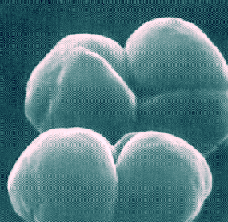Methanosarcinaceae
In taxonomy, the Methanosarcinaceae are a family of the Methanosarcinales.[1]
| Methanosarcinaceae | |
|---|---|
 | |
| Methanosarcina barkeri fusaro | |
| Scientific classification | |
| Domain: | |
| Kingdom: | |
| Phylum: | |
| Class: | |
| Order: | |
| Family: | Methanosarcinaceae |
| Binomial name | |
| Methanosarcinaceae Balch and Wolfe 1981 | |
| Genera | |
| |
Phylogeny
The currently accepted taxonomy is based on the List of Prokaryotic names with Standing in Nomenclature (LPSN)[2] and National Center for Biotechnology Information (NCBI)[3] and the phylogeny is based on 16S rRNA-based LTP release 106 by 'The All-Species Living Tree' Project.[4]
| ||||||||||||||||||||||||||||||||||||||||||||||||||||||||||||||||||||||||||||||||||||||||||||||||||||||||||||||||||||||||||||||||||||||||||||||||||||||||||
Notes:
♠ Strains found at the National Center for Biotechnology Information (NCBI) but not listed in the List of Prokaryotic names with Standing in Nomenclature (LPSN)
♦ Type strain lost or not available
Biochemistry
A notable trait of Methanosarcinaceae is that they are methanogens that incorporate the unusual amino acid pyrrolysine into their enzymes.[5] The enzyme monomethylamine methyltransferase catalyzes the reaction of monomethylamine to methane. This enzyme includes pyrrolysine. The unusual amino acid is inserted using a unique tRNA, the anticodon of which is UAG. In most organisms, and in most Methanosarcinaceae proteins, UAG is a stop codon. However in this enzyme, and anywhere else pyrrolysine is incorporated, likely through contextual markers on the mRNA, the pyrrolysine-loaded tRNA is inserted instead of the release factor. They also have a unique aminoacyl-tRNA synthetase to specifically load this tRNA with pyrrolysine. This unique adaptation is still the subject of significant study.
References
- See the NCBI webpage on Methanosarcinaceae. Data extracted from the "NCBI taxonomy resources". National Center for Biotechnology Information. Retrieved 2007-03-19.
- J.P. Euzéby. "Methanomicrobia". List of Prokaryotic names with Standing in Nomenclature (LPSN). Archived from the original on 2013-01-27. Retrieved 2011-11-17.
- Sayers; et al. "Methanomicrobia". National Center for Biotechnology Information (NCBI) taxonomy database. Retrieved 2011-06-05.
- 'The All-Species Living Tree' Project."16S rRNA-based LTP release 106 (full tree)" (PDF). Silva Comprehensive Ribosomal RNA Database. Retrieved 2011-11-17.
- Lehninger A, Nelson D, Cox M. Lehninger principles of biochemistry. 6th ed. New York: W.H. Freeman; 2013 p. 1124-1126.
Further reading
Scientific journals
- Cavalier-Smith, T (2002). "The neomuran origin of archaebacteria, the negibacterial root of the universal tree and bacterial megaclassification". Int. J. Syst. Evol. Microbiol. 52 (Pt 1): 7–76. doi:10.1099/00207713-52-1-7. PMID 11837318.
- Springer E; Sachs MS; Woese CR; Boone DR (1995). "Partial gene sequences for the A subunit of methyl-coenzyme M reductase (mcrI) as a phylogenetic tool for the family Methanosarcinaceae". Int. J. Syst. Bacteriol. 45 (3): 554–559. doi:10.1099/00207713-45-3-554. PMID 8590683.
- Cavalier-Smith, T (1986). "The kingdoms of organisms". Nature. 324 (6096): 416–417. Bibcode:1986Natur.324..416C. doi:10.1038/324416a0. PMID 2431320.
- Sowers KR; Johnson JL; Ferry JG (1984). "Phylogenic relationships among the methylotrophic methane-producing bacteria and emendation of the family Methanosarcinaceae". Int. J. Syst. Bacteriol. 34 (4): 444–450. doi:10.1099/00207713-34-4-444.
- Balch WE; Fox GE; Magrum LJ; Woses CR; et al. (1979). "Methanogens: reevaluation of a unique biological group". Microbiol. Rev. 43 (2): 260–296. doi:10.1128/MMBR.43.2.260-296.1979. PMC 281474. PMID 390357.
Scientific books
- Boone DR; Whitman WB; Koga Y (2001). "Order III. Methanosarcinales ord. nov.". In DR Boone; RW Castenholz (eds.). Bergey's Manual of Systematic Bacteriology Volume 1: The Archaea and the deeply branching and phototrophic Bacteria (2nd ed.). New York: Springer Verlag. pp. 169. ISBN 978-0-387-98771-2.
- Grant WD; Kamekura M; McGenity TJ; Ventosa A (2001). "Class III. Halobacteria class. nov.". In DR Boone; RW Castenholz (eds.). Bergey's Manual of Systematic Bacteriology Volume 1: The Archaea and the deeply branching and phototrophic Bacteria (2nd ed.). New York: Springer Verlag. pp. 169. ISBN 978-0-387-98771-2.